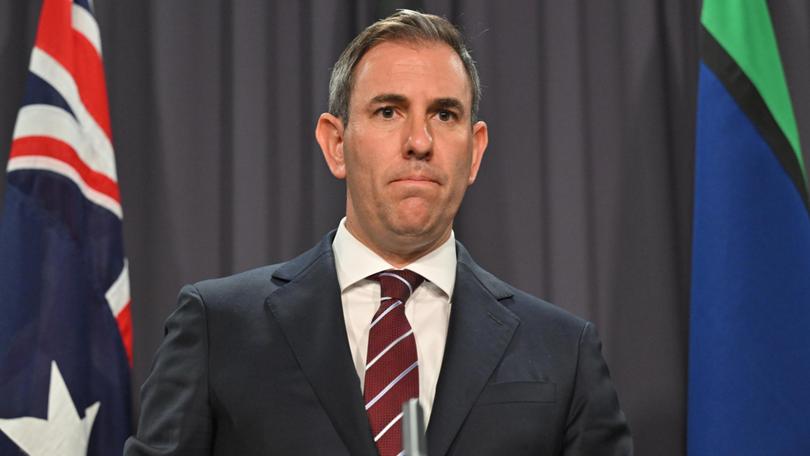Australian economy grew just 0.1pc in March quarter, new figures show

Treasurer Jim Chalmers has warned of another tough quarter for the economy after the tiniest growth in the first three months of the year.
The tiny increase of 0.1 per cent is the lowest quarterly growth since December 2020 and economic growth per capita has fallen for the fifth consecutive quarter. It’s also the worst growth outside of the pandemic for decades and, on an annual basis, the worst since the early 1990s recession.
Spending by governments and by households on essentials rose, the latter driven by electricity, health, rent and food, the Australian Bureau of Statistics on Wednesday reported.
Sign up to The Nightly's newsletters.
Get the first look at the digital newspaper, curated daily stories and breaking headlines delivered to your inbox.
By continuing you agree to our Terms and Privacy Policy.Economists had expected a quarterly increase of 0.2 per cent.
Reserve Bank of Australia governor Michele Bullock earlier on Wednesday said the economy was “very weak” and there was a prospect of no growth at all over the quarter.
On an annual basis, GDP rose just 1.1 per cent to March 31.
“Treasury expected our economy to be weak so it is not surprising to see the economy barely grew in the quarter,” Dr Chalmers said.
“Any growth is welcome in the domestic and global circumstances we confront.”
Dr Chalmers said he expects the economy to continue to grow this year, but June figures would likely be “similarly difficult”.
“Our job is to fight inflation. we’re putting downward pressure on inflation with the Budget . . . but we’ve got to do that in a way that doesn’t smash the economy,” he said, adding he expects Government measures such as energy bill relief and tax cuts to make a difference for struggling households.
Commonwealth Bank head of Australian economics Gareth Aird said: “The economic pie is still expanding modestly. But the average size of the slice of pie that each Australian has received over the past five quarters has progressively shrunk.”
The Treasurer pointed to Canada, the UK, Germany and Japan as economies Australia’s growth had surpassed on an annual basis.
He emphasised the figures were proof of the tough cost-of-living crunch in which Australians were in.
“We have a unique combination of low unemployment, a return to real wages growth, 820,000 jobs have been created since we came to office and we’re expecting back-to-back surpluses for the first time in almost two decades,” Dr Chalmers said.
Households are also saving less than in the December quarter, with the savings ration down to 0.9 per cent. Income grew at the lowest rate since December 2021 on small wage rises.
“Household spending has been more resilient than previously estimated, but now households have smaller buffers to support spending going forward,” Westpac economists Matthew Hassan and Pat Bustamante said.
While business investment was lower, led down by a reduction in mining and construction, overall investment remains high, the ABS said, and is still higher than that seen in the mining boom of the early 2010s.
The ABS also noted government spending was up one per cent through social assistance to households and via energy bill relief payments from some State Governments, as well as defence through increased military exercises.
AMP chief economist Shane Oliver noted the GDP data is not forward looking, and given the economy had shifted since March 31, including via loosening in the labour maket, there was scope for a rate cut later this year.
“Slowing economic growth leads to lower inflation,” he said.
Shadow Treasurer Angus Taylor said the figures should be a wake-up call for the Federal Government.
“Had the Prime Minister and Treasurer taken inflation seriously from day one, Australia would not be in such a dire economic situation,” he said. “But Labor’s economic mismanagement and confused priorities have created this mess.”
ANZ economists are holding to their forecast of a November rate cut.
“The pace of GDP growth over the past six months is a little weaker than we anticipated, but labour market conditions have only eased slowly over the same period while recent inflation data have shown some stickiness,” senior economist Blair Chapman said.
Betashares chief economist David Bassanese said the higher-than-expected household spending on service areas outside retail may help explain why services inflation had been so sticky so far this year.
“The RBA will be relying on continued subdued consumer spending in coming quarters to keep the economy soft and inflationary pressures contained,” he said.
“The RBA would be concerned that consumer spending on services last quarter appeared to be quite firm, even before next month’s tax cuts kick in.
“While it’s still likely the RBA will keep rates on hold for much of this year, the risks of a rate hike have not gone away despite today’s soft GDP result.”
But National Australia Bank chief economist Alan Oster said subdued growth was likely to help ease inflationary pressures.
“The path of inflation moderation is set to remain gradual and uneven, while the evolution of consumption behaviour and the labour market remain key factors,” he said.
